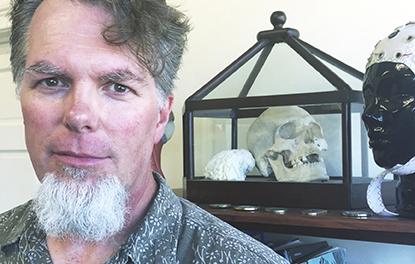
Dr. Michael Weisend
1987 BS in Biology and Psychology
During Mike Weisend’s college visit to Heidelberg, he was searching for an elusive biology professor as he contemplated a major in physics or biology. The nowhere-to-be-found professor, Dr. Bob Murray, was eventually located in a dark room, singing and strumming his guitar with students.
From that moment, I knew this was the place I wanted to be. That was the way I hoped I could interact with faculty. It was so cool,
said Weisend, ’87, now a renowned neuroscientist and soon-to-be Opening Convocation keynote speaker.
The folk-singing biology professor, a faculty icon who is now retired, may have been the catalyst, but there was much more that Weisend discovered at Heidelberg. That encounter, though, did set the stage for four productive undergrad years that led to master’s and doctoral degrees in behavioral neuroscience from the University of New Mexico.
Today, Weisend is nationally recognized for his expertise in the neurophysiology of learning, cognition and memory. He is a senior scientist with Rio Grande Neurosciences, a company that develops therapies to treat neurological conditions. He has been with Wright State University since 2013 as a senior research scientist as well.
Weisend would agree that a strong foundation for his career success was laid at Heidelberg. There were three factors at the Berg that really changed life for him – respect, support and challenge. The faculty respected students. “It was never, ‘Sit down, shut up and listen,’” he said. “We were treated like people who had brains and that was really cool.”
That respect and support from faculty gave him and other students a big boost of confidence. Finally, he felt challenged in his coursework. “That taught us not to just regurgitate what we read but to actually look in the blank spaces for possibilities.”
When we asked hard questions and we got the answer, ‘I don’t know,’ we were encouraged to look between the lines. That’s what really got my mind going in terms of brain research.
Describing his work, Weisend explained, “We map ‘em and zap ‘em.” All witticism aside, he is involved in pioneering work that utilizes some of the most sophisticated neuroimaging techniques to gather data about how the brain functions – or fails to function. He and his team develop advanced hardware and software for electrical and magnetic non-invasive brain stimulation techniques to enhance memory and other aspects of human performance, such as learning.
Weisend hopes that some day this work will develop enough to treat brain disease. One specific brain disease has caught Weisend’s attention – for personal and professional reasons: dementia. Ultimately, his goal would be to find a way through his work to help people afflicted with the devastating illness. “As things move along,” he said, “I would love to figure out a way to map brain activity and apply electricity to make something happen for people who walk down that path,” he said
To that end, Weisend has recently moved from academia into business, primarily because there’s preferred financial support in industry to fund technological innovations and development of pioneering therapies. He has found a group willing to support his work to build the system he needs to address dementia, he said.
Throughout the course of his career, he has secured nearly $12 million in public and private funding to support his research from such agencies as the National Alliance for Schizophrenia and Depression, the Veterans Administration, National Institutes of Health, the Defense Advanced Research Projects Agency and multiple industry contracts.
This may be just the beginning, though.
“Ten years from now is when things will really start gelling for the general public,” he said, “and we are working hard to lead the way.”